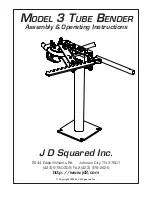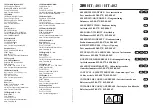
D
–10
Appendix D
P a r a m e t e r a n d w h a t i t d o e s
Definition
Notes
p e r i o d
Period of a cyclic signal measured as
time between every other pair of 50 %
crossings. Starting with first transition
after left cursor, period is measured for
each transition pair, with values averaged
to give final result.
(
)
∑
=
−
Mr
i
i
i
Tr
Tr
Mr
1
50
50
1
(See Fig. D–2)
Where:
Mr
is the number of
leading edges found,
Mf
the
number of trailing edges
found,
x
i
Tr
the time when rising
edge
i
crosses the x % level,
and
x
i
Tf
the time when falling
edge
i
crosses the x % level.
pkpk
Peak–to–peak: Difference between
highest and lowest points in waveform.
Unlike ampl, does not assume the
waveform has two levels.
maximum
-
minimum
(See Fig. D–1)
Gives a similar result when applied to
time domain waveform or histogram
of data of the same waveform. But
with histograms, result may include
contributions from more than one
acquisition.
phase
Phase difference between signal analyzed
and signal used as reference.
Phase difference
between signal
and reference
points
Number of points in the waveform between
the cursors.
Number of points
between cursors
(See Fig. D–2)
r20–80%
Rise 20 % to 80 %: Duration of pulse
waveform's rising transition from 20% to
80%, averaged for all rising transitions
between the cursors.
Average duration
of rising 20–80 %
transition
On signals
NOT
having two
major levels (triangle or saw-
tooth waves, for example), top
and base can default to
maximum and minimum,
giving, however, less
predictable results.
r@level
Rise at level: Duration of pulse
waveform's rising edges between
transition levels.
Duration of rising
edges between
transition levels
On signals
NOT
having two
major levels (triangle or saw-
tooth waves, for example), top
and base can default to
maximum and minimum,
giving, however, less
predictable results.
r i s e
Rise time: Measures time between two specified
values on waveform’
s rising edge (10–90 %). Rise
times for each edge averaged to give final result.
Time at upper
threshold
-
Time at
lower threshold
averaged over each
rising edge
(See Fig. D–1)
On signals
NOT
having two
major levels (triangle or saw-
tooth waves, for example), top
and base can default to
maximum and minimum,
giving, however, less
predictable results.
Summary of Contents for 9300C Series
Page 1: ...Operator s Manual LeCroy 9300C Series Digital Oscilloscopes Revision A January 1998 ...
Page 8: ...1 3 billed for parts and labor related to the repair work and for shipping ...
Page 18: ...4 1 4 Introduction to the Controls Two Channel Front Panel ...
Page 19: ...4 2 Introduction to the Controls Four Channel Front Panel ...
Page 92: ......
Page 111: ...11 3 Dual Quad ...
Page 112: ...11 4 Display Parameter s XY only ...
Page 113: ...11 5 XY Single XY Dual ...
Page 138: ...12 21 Ø FLASH UPDATE Offering the Update from and Update Program menus illustrated next page ...
Page 139: ...12 22 UTILITIES The full screen warning message shown when FLASH UPDATE has been selected ...
Page 142: ...13 2 WAVEFORM STORE RECALL ...
Page 182: ......
Page 189: ...A 15 9344C Series 9350C Series 9354C Series 9354CTM 50 000x 9344CL 9350CL 9354CL 100 000x ...
Page 252: ...E 6 Appendix E ...
Page 275: ...Index 9370C 9374C Series A 18 9384C Series A 24 Zoom menu 10 7 Zoom of Math Functions 10 1 ...
















































